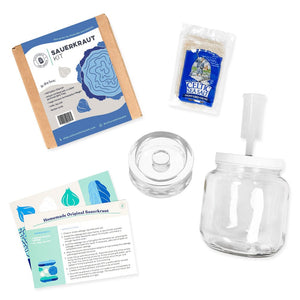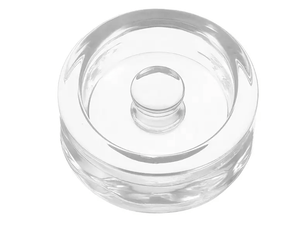
If you are trying to avoid refined salt or are on a low sodium diet, you can still enjoy delicious sauerkraut. This recipe uses herbal seeds to replace the salt in normal kraut. Making this kind of ferment is a bit riskier when it comes to foreign bacteria having a foothold, so it is recommended that you make this kind of kraut in the winter and keep a close eye on it during fermentation.
60 minutes
48 minutes
2
INGREDIENTS AND EQUIPMENT AVAILABLE AT CULTURES FOR HEALTH
Sauerkraut Making Kits

Sauerkraut Making Kits
$35.99
Make delicious, tangy sauerkraut at home with our DIY Sauerkraut Kit!
This kit is also great for making kimchi, pickles, and other fermented vegetables! Equipment in the kit may appear different than pictured.
Pickle Packer Vegetable Tamper

Pickle Packer Vegetable Tamper
$19.95
Pack in vegetables for small-batch fermentation with this Pickle Packer.
Large Ceramic Fermentation Weight

Fermentation Weight
$6.49
Weigh down your fermented vegetables using this fermentation weight. Keeping vegetables weighted under the brine keeps the vegetables from drying out and can help prevent mold.
INGREDIENTS:
- 5 pounds cabbage
- 1 Tbsp. caraway seeds
- 1 Tbsp. dill seeds
- 1 Tbsp. celery seeds
- 1 Tbsp. crushed peppercorns
- Filtered water
INSTRUCTIONS:
- Shred or finely chop cabbage. Place in a non-metal bowl.
- Grind seeds and peppercorns with a mortar and pestle; toss ground seeds in the bowl with the cabbage until well blended. Pound the mixture a little with a Cabbage Crusher or pounding tool to get the juices flowing.
- Pack the cabbage mixture into the clean jar, rather tightly. Add just enough water to bring the liquid level to just above the cabbage.
- Weigh the cabbage down with a fermenting weight, if needed.
- Cover the jar with a tight lid, airlock lid, or coffee filter secured with a rubber band.
- Culture at room temperature (60-70°F is preferred).
- Check the kraut's aroma and water level daily; replenish the water if needed. If it starts to smell anything but sour, start again. Making kraut without salt is doable, but is a risk, so be attentive and aware of what the ferment is doing and keep it happy. Mold may appear on the surface, but don’t worry about it unless the mold is dark-colored.
- Sauerkraut should start to get tangy within about 5 days. Continue tasting daily and place in cold storage when it reaches desired flavor.
















